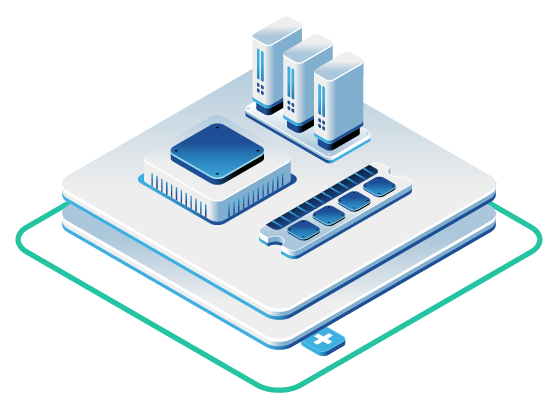AI workload costs hit $85,521 monthly in 2025, up 36% year-over-year, while 94% of IT leaders struggle with cost optimization. Variable hyperscaler billing creates 30-40% monthly swings that make financial planning impossible. Fixed-cost infrastructure with dedicated GPUs eliminates this volatility.
Category: Bare Metal and Dedicated Servers
Render Network, Akash, io.net, and Gensyn nodes fail on AWS because virtualization breaks hardware attestation. DePIN protocols need cryptographic proof of physical GPUs and hypervisors mask the identities protocols verify. This guide covers why bare metal works, real operator economics, and setup.
AI startups hit sticker shock when Pinecone bills jump from $50 to $3,000/month. This analysis reveals the exact tipping point where self-hosting vector databases on OpenMetal becomes cheaper than SaaS. Includes cost comparisons, migration guides for Qdrant/Weaviate/Milvus, and real ROI timelines.
OpenMetal offers five hardware generations across hosted private cloud and bare metal deployments. This guide breaks down the specs, performance differences, and use cases for each generation from V1’s foundation infrastructure to V4’s latest enterprise hardware, helping you choose the right configuration for development, production, or hybrid workloads.
Overcome the trust barrier in enterprise AI. This guide details how to deploy vector databases within Intel TDX Trust Domains on OpenMetal. Learn how Gen 5 hardware isolation and private networking allow you to run RAG pipelines on sensitive data while keeping it inaccessible to the provider.
Are overlay networks killing your Kubernetes performance? Discover why running Cilium on OpenMetal bare metal outperforms virtualized clouds. We provide a technical guide on switching to Direct Routing, configuring Jumbo Frames, and leveraging dedicated hardware to maximize eBPF efficiency.
Maximize density with 5th Gen Intel Xeon. We benchmark OpenMetal’s Large V4 servers to reveal 21% better compute, 14x faster AI inference via AMX, and secure confidential computing with TDX. Eliminate the GPU tax and future-proof I/O.
Hyperscalers like AWS and GCP block custom email services, pushing you to their metered APIs. Learn why this conflict of interest hurts your business and how to build a scalable, high-volume email platform on OpenMetal’s dedicated hardware with BYOIP, private networking, and no sending limits.
Hyperscalers lock you in by owning your IP addresses. Moving infrastructure means updating firewall rules, losing email reputation, and coordinating DNS changes across partners. BYOIP gives you control over your network identity. Learn why this matters for multi-region, hybrid, and enterprise workloads.
Deploying Proxmox VE on OpenMetal bare metal eliminates virtualization licensing costs while providing enterprise features like HA clustering and live migration. Organizations achieve 50%+ savings versus public cloud with predictable monthly pricing. Dedicated hardware delivers consistent performance without resource contention, making this combination ideal for production workloads, database consolidation, and VMware migrations.
The 2018 Spectre, Meltdown, and Foreshadow vulnerabilities exposed fundamental CPU flaws that shattered assumptions about hardware isolation. Learn how these attacks sparked the confidential computing revolution and how OpenMetal enables Intel TDX on enterprise bare metal infrastructure.
Design fault-tolerant validator infrastructure combining dedicated bare metal performance, redundant networking, self-healing Ceph storage, and OpenStack orchestration for maintaining consensus uptime through failures.
Discover how to transition your OpenMetal private cloud from proof of concept to production. Learn expansion strategies using converged nodes, compute resources, storage clusters, and GPU acceleration for real-world workloads at scale.
Cloud infrastructure often represents one of the largest—and least understood—expenses during technical diligence. Learn what to evaluate, which red flags to watch for, and how transparent infrastructure platforms simplify the assessment process for PE firms evaluating SaaS acquisitions.
Discover how OpenMetal’s storage servers solve the hot-to-cold storage challenge with hybrid NVMe and HDD architectures powered by Ceph. Get enterprise-grade block, file, and object storage in one unified platform with transparent pricing — no egress fees, no vendor lock-in, and full control over your private cloud storage infrastructure.
Cross-border data transfer regulations are tightening globally. Confidential computing provides enterprises with verifiable, hardware-backed protection for sensitive workloads during processing. Learn how CTOs and CISOs use Intel TDX, regional infrastructure, and isolated networking to meet GDPR, HIPAA, and PCI-DSS requirements.
Blockchain validators demand millisecond precision and unthrottled performance. Public cloud throttling, unpredictable costs, and resource sharing are driving operators to bare metal infrastructure. Learn why dedicated hardware with isolated networking eliminates the risks that shared environments create.
Discover how big data analytics combined with dedicated bare metal infrastructure enables real-time fraud detection systems that analyze millions of transactions with sub-100ms latencies, eliminating the performance variability and unpredictable costs of public clouds while achieving 30-60% infrastructure savings.
Discover how to build production-grade time-series databases on OpenMetal’s dedicated bare metal infrastructure. This comprehensive guide covers time-series fundamentals, popular open-source options like ClickHouse and TimescaleDB, and provides a detailed deployment blueprint with infrastructure optimization strategies.
Private equity firms are replacing variable cloud costs with fixed-cost infrastructure to improve EBITDA predictability and portfolio valuations. Learn how transparent, hardware-based pricing creates financial advantages for PE-backed SaaS companies.
Discover how OpenMetal’s strategically positioned data centers eliminate the “data tax” on globally distributed applications. Free east-west traffic between regions plus predictable 95th percentile bandwidth billing lets you architect for performance instead of cost avoidance, with typical savings of 30-60% versus public cloud.
DevOps teams need more than restricted cloud access. OpenMetal provides full root access to dedicated bare metal infrastructure, enabling complete control over hardware and software stacks. Deploy custom configurations, implement infrastructure as code, and optimize performance without vendor limitations, all in 45 seconds.
Network spikes test validator infrastructure beyond normal limits. Discover how bare metal servers deliver the consistent performance, predictable costs, and operational control needed to maintain validator operations during high-stress network events while maximizing rewards.
Confidential cloud storage with Ceph combines distributed architecture, hardware-backed security, and OpenStack orchestration to protect sensitive data at scale. Learn how OpenMetal delivers secure storage for regulated industries.
PE firms struggle with fragmented infrastructure across portfolio companies. Private cloud standardization delivers 30-50% cost savings, predictable EBITDA, and operational efficiency across all holdings.
Real-time AI applications require consistent sub-100ms performance that multi-tenant cloud GPU instances can’t deliver. Explore how dedicated bare-metal H100/H200 clusters eliminate noisy neighbor effects, provide predictable pricing, and deliver the performance consistency needed for production inference systems.
Learn how bare metal infrastructure with private cloud powered by OpenStack delivers the security, compliance, and control that confidential workloads require – from healthcare to finance to blockchain applications.
SaaS companies preparing for exit can achieve premium valuations through private cloud infrastructure that delivers predictable costs, margin stability, and operational discipline that buyers reward with higher multiples.
Discover how blockchain teams build complete infrastructure stacks using dedicated compute, storage, and networking instead of basic hosting. Learn why validator nodes, RPC endpoints, and data-heavy applications need integrated infrastructure control to achieve predictable performance and scale reliably.
Private equity firms are systematically implementing cloud repatriation strategies across SaaS portfolios to convert unpredictable cloud costs into fixed expenses, typically reducing infrastructure spending by 30-50% while improving EBITDA forecasting accuracy. This strategic shift addresses the margin compression caused by usage-based cloud billing and creates sustainable competitive advantages for portfolio companies.
The cloud landscape is shifting, and infrastructure leaders are taking notice. In a recent episode of The Cloudcast, OpenMetal’s founder and president Todd Robinson sat down with hosts Aaron Delp and Brian Gracely to explore why bare metal and private cloud are experiencing a comeback.
Healthcare organizations can now train AI models on sensitive patient data without exposing it to public cloud vulnerabilities. Confidential computing creates hardware-protected environments where PHI remains secure during processing, enabling breakthrough AI development while maintaining HIPAA compliance and reducing regulatory overhead.
Cloud costs eating your EBITDA? CFOs and Operating Partners need strategic alignment to tackle unpredictable public cloud pricing. Discover how fixed pricing models deliver 20-30% savings and financial predictability for PE-backed SaaS companies.
Learn how confidential computing enables secure, high-performance workloads by combining Intel TDX hardware isolation with GPU acceleration. Explore real-world applications in AI training, blockchain validation, and financial analytics while maintaining data confidentiality and computational speed.
Discover how to build private HPC clusters that deliver the performance, control, and cost predictability your scientific simulations and financial models demand. Learn about hardware configurations, network architecture, and deployment strategies that outperform traditional cloud options.
Learn how to build a massively parallel processing data warehouse using Greenplum on OpenMetal’s bare metal infrastructure. Discover architecture best practices, performance advantages, and cost optimization strategies for large-scale analytical workloads that outperform traditional public cloud deployments.
Discover how portfolio managers are transforming blockchain startup growth with predictable infrastructure costs. OpenMetal’s fixed-cost bare metal eliminates unpredictable cloud expenses, delivering 30-60% savings when monthly spend hits $20,000. Learn the infrastructure strategy that’s reshaping blockchain investment returns.
Learn how OpenMetal’s bare metal servers and private clouds eliminate performance jitters in Apache Storm/Flink deployments, delivering consistent low-latency stream processing with predictable costs and full hardware control for enterprise real-time data workloads.
Discover how private cloud infrastructure provides the controlled environment needed for confidential computing workloads. Learn about hardware isolation, network security, and why dedicated infrastructure beats public cloud for sensitive data processing.
Blockchain infrastructure demands storage that scales with validator nodes, terabytes of historical data, and unpredictable state growth. Ceph distributed storage offers a unified solution that handles these challenges while eliminating the unpredictable costs and performance bottlenecks of traditional cloud storage.
Bare metal confidential computing eliminates virtualization overhead, resource constraints, and unpredictable costs. OpenMetal’s dedicated TDX servers deliver consistent performance for sensitive AI, blockchain, and financial workloads where security can’t be compromised.
Discover why dual smaller NVMe drives outperform single larger drives for enterprise databases on bare metal infrastructure. Learn about workload separation, parallel I/O, and endurance benefits with Micron 7500 MAX SSDs on OpenMetal’s XLv4 and XXLv4 servers for mission-critical applications.
Learn how to deploy and optimize Apache Spark and Hadoop clusters on OpenMetal’s bare metal infrastructure. This comprehensive guide covers deployment strategies, storage architecture, system tuning, and real-world optimization techniques for maximum performance and cost efficiency.
Private equity operating partners are missing a major value creation opportunity by not tracking infrastructure optimization as a KPI. Cloud costs often represent 50% of software companies’ revenue, directly impacting EBITDA and valuations. This guide shows how to make infrastructure efficiency measurable and systematically improve portfolio company margins through predictable, optimized infrastructure strategies.
Discover how OpenMetal’s on-demand private cloud with integrated Ceph storage eliminates AI infrastructure bottlenecks. Real customer case study shows 50% cost reduction and seamless scaling from 0.5PB to 1.9PB capacity. Get enterprise-grade performance with predictable pricing.
Learn how OpenMetal’s dedicated VLAN and VXLAN-ready private cloud architecture provides secure multi-tenant environments with true Layer 2 isolation, unlimited scalability, and unmetered 20 Gbps private networking for compliance-ready deployments.
Infrastructure inconsistency silently undermines SaaS scalability, creating performance unpredictability, security gaps, and operational complexity. This comprehensive guide shows technical leaders how to achieve consistency without sacrificing agility through dedicated private cloud infrastructure, standardized deployment patterns, and systematic implementation strategies that prevent configuration drift while supporting rapid growth.
Privacy-first blockchain applications need infrastructure that supports confidential computing, network isolation, and regulatory compliance. Discover how bare metal and private cloud solutions provide the foundation for zero-knowledge proofs, confidential smart contracts, and secure multi-party computation.
Learn how to architect a complete predictive analytics pipeline using OpenMetal’s dedicated infrastructure. This technical guide covers Ceph storage, GPU training clusters, and OpenStack serving – delivering superior performance and cost predictability compared to public cloud alternatives.
Hidden cloud costs are silently destroying SaaS profit margins. PE firms lose billions in portfolio value due to unpredictable usage fees, resource waste, and egress charges. Learn how private cloud infrastructure delivers 30-50% cost savings and predictable EBITDA improvement.
PE firms face mounting cloud costs across SaaS portfolios. Learn how OpenMetal’s private cloud delivers 30-60% cost savings, predictable pricing, and improved margins that directly boost portfolio valuations and exit multiples.
Learn how OpenMetal’s private networking architecture delivers 20 Gbps per server, free internal traffic, customer-specific VLANs with VXLAN support, and predictable egress billing. Perfect for AI training clusters, database replication, and high-throughput workloads requiring performance without bandwidth constraints.
Public cloud confidential computing promises security but retains provider control over critical trust components. Private cloud infrastructure eliminates third-party trust dependencies, providing genuine confidentiality for sensitive workloads through dedicated hardware and transparent attestation.
Learn how PostgreSQL and Citus on OpenMetal deliver enterprise-scale data warehousing with distributed SQL performance, eliminating vendor lock-in while providing predictable costs and unlimited scalability for modern analytical workloads.
Explore how confidential computing transforms blockchain security by protecting oracle data feeds and smart contract execution. This guide covers implementation strategies, performance optimization, and deployment best practices for building secure decentralized applications on OpenMetal’s bare metal infrastructure.
Discover five blockchain workloads that demand dedicated infrastructure over shared public cloud. From validator nodes to MEV systems, learn why bare metal servers and private cloud provide the performance, security, and control these critical operations require.
Learn how confidential computing infrastructure protects PHI, AI models, and proprietary algorithms during processing. Discover implementation strategies for HIPAA-compliant AI workloads on OpenMetal’s secure bare metal platform, including real-world healthcare use cases and deployment guides.
Retail brands face a dilemma: AI image generation tools offer unprecedented speed, but public APIs expose intellectual property, violate compliance, and create unpredictable costs. Private AI infrastructure solves these challenges while delivering superior ROI.
Regulated financial institutions need blockchain infrastructure that balances innovation with compliance. Discover why bare metal servers deliver the control, performance, and security that enterprise blockchain demands—from validator nodes to tokenization platforms. No compromise required.
MPC lets multiple parties compute together without sharing private data — but infrastructure matters. Learn how confidential computing on OpenMetal bare metal servers with Intel TDX helps secure MPC deployments for blockchain, fintech, and privacy-first apps.
Modular blockchain networks like Celestia, Cosmos, and Polygon CDK are redefining infrastructure needs. This post outlines why bare metal servers and private clouds offer the control, performance, and predictability that modular blockchains require.
Tired of siloed data lakes and warehouses? This article shows data architects how, why, and when to build a unified lakehouse. Learn how to combine raw data for ML and structured data for BI into one system, simplifying architecture and improving business insights.
Chennai businesses benefit from hosting their applications on OpenMetal’s dedicated servers and cloud infrastructure located in Singapore.
Choosing a database? We compare traditional Azure SQL with a distributed TiDB cluster on OpenMetal. See how TiDB’s distributed design is able to fully tap into the power of ephemeral NVMe for speed and resilience, offering huge TCO savings by eliminating licensing and high egress fees.
This guide makes confidential computing practical. Explore how to reduce deployment complexity using OpenMetal’s secure, TDX-enabled infrastructure.
Are you a data architect or developer frustrated by slow and unreliable data pipelines? This article provides a high-performance blueprint using Apache Spark, Delta Lake, and Ceph on OpenMetal’s bare metal cloud. Escape the “hypervisor tax” and build scalable, cost-effective ETL systems with direct hardware control for predictable performance.
Hong Kong businesses benefit from hosting their applications on OpenMetal’s dedicated servers and cloud infrastructure located in Singapore.
Kuala Lumpur businesses benefit from hosting their applications on OpenMetal’s dedicated servers and cloud infrastructure located in Singapore.
Bangkok businesses benefit from hosting their applications on OpenMetal’s dedicated servers and cloud infrastructure located in Singapore.
This guide makes confidential computing practical. Explore how to reduce deployment complexity using OpenMetal’s secure, TDX-enabled infrastructure.
Learn how media companies can deploy OpenAI Whisper on a private GPU cloud for large-scale, real-time transcription, automated multilingual subtitling, and searchable archives. Ensure full data sovereignty, predictable costs, and enterprise-grade security for all your content workflows.
Learn how to improve confidential computing performance using Intel TDX, bare metal, and GPU passthrough without sacrificing security.
Discover how IT teams can deploy BioGPT on OpenMetal’s dedicated NVIDIA GPU servers within a private cloud powered by OpenStack. Learn strategic best practices for compliance-ready setups (HIPAA, GDPR), high-performance inference, cost transparency, and in-house model fine-tuning for biomedical research.
Explore how MicroVMs deliver fast, secure, and resource-efficient horizontal scaling for modern workloads like serverless platforms, high-concurrency APIs, and AI inference. Discover how OpenMetal’s high-performance private cloud and bare metal infrastructure supports scalable MicroVM deployments.
Learn how to deploy confidential computing workloads on bare metal using Intel TDX, OpenMetal servers, and secure infrastructure best practices.
Learn how to enable Intel SGX and TDX on OpenMetal’s Medium, Large, XL, and XXL v4 servers. This guide covers required memory configurations (8 DIMMs per CPU and 1TB RAM), hardware prerequisites, and a detailed cost comparison for provisioning SGX/TDX-ready infrastructure.
A quick list of some of the most popular Hugging Face models / domain types that could benefit from being hosted on private AI infrastructure.
Discover how OpenMetal delivers performance and flexibility through tiered cloud storage options. Learn the pros and use cases of direct-attached NVMe, Ceph-based high availability block storage, and scalable, low-cost erasure-coded object storage—all integrated into OpenStack.
Discover the power of the OpenMetal Large v4 Storage Server with dual Intel Xeon Silver 4510 CPUs, 720TB HDD storage, 76.8TB NVMe flash, and 512GB DDR5 RAM. Perfect for building high-performance, scalable, and resilient storage clusters for cloud, AI/ML, and enterprise data lakes.
A crypto trading firm deployed blockchain infrastructure on bare metal to run Solana validator workloads with low latency and full control.
A Web3 team deployed blockchain infrastructure on bare metal and Ceph storage to scale decentralized workloads and cut storage costs.
With the new OpenMetal Private AI Labs program, you can access private GPU servers and clusters tailored for your AI projects. By joining, you’ll receive up to $50,000 in usage credits to test, build, and scale your AI workloads.
As blockchain technology moves beyond cryptocurrency, more companies are running blockchain workloads on bare metal to meet growing demands for speed, security, and control. This post explores how it works, why it matters, and where it’s already being used in real-world industries.
GPU Servers and Clusters are now available on OpenMetal—giving you dedicated access to enterprise-grade NVIDIA A100 and H100 GPUs on fully private, high-performance infrastructure.
Discover how machine learning and data analytics teams could accelerate training, inference, and data pipelines using OpenMetal’s infrastructure. This example setup combines a Large v3 Cloud Core with high-capacity Storage v3 servers, NVMe speed, and 95th percentile egress pricing.
The OpenMetal Large v1 Storage Server features dual Intel® Xeon® Silver 4210R CPUs, 12x 12TB HDDs, and 4x 1.92TB NVMe SSDs—ideal for scalable, high-capacity storage and Ceph-based clusters.
Discover the OpenMetal Large v3 Storage Server, featuring 12x18TB HDDs, customizable NVMe flash options up to 15.36TB per drive, and the Intel Xeon Silver 4314 processor. Ideal for Ceph-based clusters, it delivers scalable performance, hot-swappable flexibility, and enterprise-grade storage.
Explore how a 3D model hosting platform could scale using OpenMetal’s Storage Large servers. With hybrid NVMe/HDD storage, powerful compute, and 95th percentile egress billing, OpenMetal offers an ideal infrastructure model for content-rich applications.
OpenMetal’s Storage Large v1 and v3 bare-metal servers deliver scalable hybrid storage, powerful compute, and 95th percentile bandwidth pricing. Ideal for demanding workloads like AI, blockchain, media production, and data analytics—without surprise egress fees.
At OpenMetal, every bare metal server is deployed with dual high-speed 10Gbps uplinks, providing a critical layer of both performance scalability and fault tolerance. To fully leverage these redundant connections, OpenMetal configures these uplinks as a bonded logical interface using Link Aggregation Control Protocol (LACP).
At OpenMetal, we design our bare metal servers for high availability, ensuring resilience across private clouds and storage clusters. To protect the operating system from hardware failures, many servers feature dual boot drives in RAID 1, providing redundancy and seamless recovery.
Learn how to self-host ClickHouse on OpenMetal’s bare metal servers for unmatched performance and cost-effectiveness. This step-by-step guide provides everything you need to deploy the ideal ClickHouse instance for your business.
Looking for a high-performance, secure, and flexible cloud solution for your manufacturing business? OpenMetal offers bare metal cloud for manufacturing, providing dedicated infrastructure and complete control.
Need high-performance, predictable cloud infrastructure? Learn how Stakater partnered with OpenMetal to achieve consistent performance for their demanding workloads, improve resource utilization, and gain better cost control.
Our year was a busy one! From major platform updates like a revamped OpenMetal Central and Private Cloud Core v3 releases to new partnerships and customer success stories. Revisit the highlights of 2024 with us!
Simplify your cloud infrastructure provider search! This guide outlines essential questions to answer before engaging vendors. Prepare your requirements, get accurate quotes faster, and ensure a seamless migration. You’ll save time and resources by being prepared!
OpenMetal’s Medium v4 bare metal dedicated server is powered by dual 5th gen Intel® Xeon Silver 4510 processors and 256 DDR5 RAM.
OpenMetal’s XXL v4 bare metal dedicated server is powered by dual 5th gen Intel® Xeon Gold 6530 processors and 2048GB DDR5 RAM.
OpenMetal’s Large v4 bare metal dedicated server is powered by dual Intel® Xeon Gold 6526Y processors, 512GB DDR5-5200 RAM, and come with two Micron 7450 MAX drives.
Discover how OpenMetal’s generous bandwidth allotments and 95th percentile egress pricing can help hosting providers cut costs while boosting capacity for high-traffic, content-rich sites
Ensure uninterrupted service for your critical applications with our comprehensive guide to high-availability infrastructure solutions. Discover the importance of redundancy, failover, and fault tolerance, and explore popular technologies like OpenStack, bare metal servers, and Ceph storage clusters. Learn how to build resilient systems that can withstand failures and minimize downtime.
Explore Intel® (TDX), a hardware-based technology designed to enhance the security and privacy of virtualized workloads in cloud environments.
Learn about the need for confidential computing, its benefits, and some top industries benefiting from this technology.
The bare metal cloud market is poised for significant growth in the coming years, fueled by the rapid advancements in artificial intelligence (AI) and machine learning (ML), as well as the increasing demand for high-performance computing (HPC).
OpenMetal’s XL v4.0 bare metal servers are powered by dual Intel Xeon Gold 6530 processor and 1TB RAM.
Madrid, Spain based businesses benefit from hosting their applications on OpenMetal’s dedicated servers located in Amsterdam, Netherlands.
Paris, France based businesses benefit from hosting their applications on OpenMetal’s dedicated servers located in Amsterdam, Netherlands.
London, Great Britain based businesses benefit from hosting their applications on OpenMetal’s dedicated servers located in Amsterdam, Netherlands.
Hamburg, Germany based businesses benefit from hosting their applications on OpenMetal’s dedicated servers located in Amsterdam, Netherlands.
Frankfurt, Germany based businesses benefit from hosting their applications on OpenMetal’s dedicated servers located in Amsterdam, Netherlands.
Berlin, Germany based businesses benefit from hosting their applications on OpenMetal’s dedicated servers located in Amsterdam, Netherlands.
Seattle based businesses benefit from hosting their applications on OpenMetal’s dedicated servers located in Los Angeles, CA.
Ready to get started with OpenStack? Read this guide to gain valuable insights on the best hardware for your OpenStack deployment. On-Demand private clouds powered by OpenStack is OpenMetal’s flagship product, so as you may guess we know a few things about building clouds built on OpenStack, including how to automate clouds built on OpenStack for deployment in under 1 minute. In this blog we share some hardware recommendations with you, to ensure that your OpenStack journey is successful.
Los Angeles based businesses benefit from hosting their applications on OpenMetal’s dedicated servers located in Los Angeles, CA.
OpenMetal’s XL v3.0 bare metal dedicated server is powered by dual Intel Xeon Gold 6430 processor and 1TB RAM.
With more focus on big data and the need to translate many data sources to other data consumers, Apache Kafka has emerged as the leading tool for efficiently and reliably handling this. In addition to configurations, maximizing Kafka’s capabilities is tied directly to the infrastructure you select.
San Jose based businesses benefit from hosting their applications on OpenMetal’s dedicated servers located in Los Angeles, CA.
San Francisco based businesses benefit from hosting their applications on OpenMetal’s dedicated servers located in Los Angeles, CA.
San Diego based businesses benefit from hosting their applications on OpenMetal’s dedicated servers located in Los Angeles, CA.
Sacramento based businesses benefit from hosting their applications on OpenMetal’s dedicated servers located in Los Angeles, CA.
Houston based businesses benefit from hosting their applications on OpenMetal’s dedicated servers located in Ashburn, Virginia.
Atlanta based businesses benefit from hosting their applications on OpenMetal’s dedicated servers located in Ashburn, Virginia.
Jacksonville based businesses benefit from hosting their applications on OpenMetal’s dedicated servers located in Ashburn, Virginia.
Chicago based businesses benefit from hosting their applications on OpenMetal’s dedicated servers located in Ashburn, Virginia.
Washington, D.C. based businesses benefit from hosting their applications on OpenMetal’s dedicated servers located in Ashburn, Virginia.
Philadelphia based businesses can benefit from hosting their applications on OpenMetal’s dedicated servers located in data centers in Ashburn, Virginia and Los Angeles, California.
New York City based businesses can benefit from hosting their applications on OpenMetal’s dedicated servers located in data centers in Ashburn, Virginia and Los Angeles, California.
OpenMetal’s XL v2.1 bare metal dedicated servers are provisioned on Supermicro’s SYS-120C-TN10R. with Intel Xeon Gold processors and 1TB RAM.
ClickHouse is an open source columnar database management system created by Yandex in 2016. ClickHouse was designed to provide users with a rapid and efficient system for processing large-scale analytical queries on enormous volumes of data. Today, organizations use ClickHouse for data warehousing, business intelligence, and analytical processing.
Boston based businesses can benefit from hosting their applications on OpenMetal’s dedicated servers located in data centers in Ashburn, Virginia and Los Angeles, California.
Picture having a dedicated physical server exclusively at your disposal, brimming with processing power, memory, and storage. No resource-sharing, no virtualization layers – just pure performance, security, and control. That’s the power of bare metal.
In the landscape of big data analytics, Apache Spark has emerged as a powerful tool for in memory big data processing. The foundation for maximizing Spark’s capabilities lies in the infrastructure. OpenMetal’s XL V2.1 servers offer a solution that marries high performance with cost-effectiveness for Spark clusters.
When it comes to processing big data, Hadoop clusters are a popular and mature open source system that enables businesses to analyze vast amounts of data efficiently.
That’s why our OpenMetal Storage XL V2 servers are designed to offer optimal performance for Hadoop environments.
This article defines big data and its applications, the big data solutions platform that process the data, and big data infrastructure requirements necessary to support operational efficiencies.
The adoption of Infrastructure-as-a-Service (IaaS) is on the rise as businesses seek to harness the scalability, flexibility, and cost-effectiveness of cloud computing. While virtualization has been a central component of IaaS, the integration of bare metal servers introduces a new dimension to infrastructure management.
Ironic, a vital part of OpenStack, focuses on provisioning and managing bare metal servers. It seamlessly integrates with Keystone, Nova, Neutron, Glance, and Swift to provide a unified interface for managing hardware resources within a cloud environment. With Ironic, operators can treat physical servers like virtual machines, streamlining the management of resources in an OpenStack cloud. It simplifies bare metal management through a unified interface, seamless integration with OpenStack services, and automated provisioning.


































